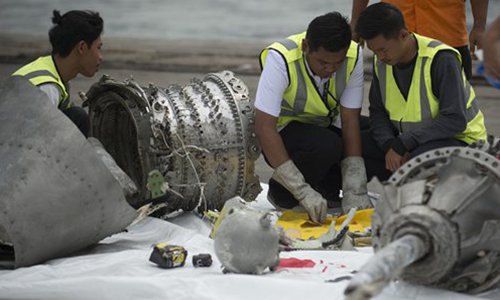Boeing design flaws linked to Lion Air disaster: investigators

Investigators examine engine parts from the ill-fated Lion Air flight JT 610 at a port in Jakarta on Wednesday, after they were recovered from the bottom of the Java Sea. The jet that plunged into the sea on October 29 had an air speed indicator problem on its fatal flight and on three previous journeys. Photo: AFP
Mechanical and design issues contributed to the crash of a Lion Air 737 MAX jet in October 2018, Indonesian investigators told victims' families in a briefing on Wednesday ahead of the release of a final report.
Contributing factors to the crash of the new Boeing jet, which killed all 189 on board, included incorrect assumptions on how an anti-stall device called the Maneuvering Characteristics Augmentation System (MCAS) functioned and how pilots would react, slides in the presentation showed.
The briefing slides also showed that a lack of documentation about how systems would behave in the crash scenario, including the activation of a "stick shaker" device that warned pilots of a dangerous loss of lift, also contributed.
"Deficiencies" in the flight crew's communication and manual control of the aircraft contributed as well, the slides showed, as did alerts and distractions in the cockpit.
The deficiencies had been "identified during training," the slides said, without adding details.
Reliance on a single angle-of-attack sensor made the MCAS system more vulnerable to failure, while the sensor on the plane that crashed had been incorrectly calibrated during an earlier repair, according to the slides.
The final report will be released on Friday.
A Boeing spokeswoman declined to comment on the briefing, saying, "As the report hasn't been officially released by the authorities, it is premature for us to comment on its contents."
A Lion Air representative declined to comment.
The 737 MAX was grounded worldwide after a second deadly crash in Ethiopia in March 2019.
US planemaker Boeing is under growing pressure to explain what it knew about 737 MAX problems before the aircraft entered service, especially after a report on messages from a former test pilot describing erratic software behavior on the 737 MAX jet two years before recent crashes.
Boeing has already said it would redesign the anti-stall system to rely on more than a single sensor and to help reduce pilot workload.
Contact with the Boeing 737 MAX jet was lost 13 minutes after it took off on October 29 from the capital, Jakarta, heading north to the tin-mining town of Pangkal Pinang.
The airplane had suffered a sequence of problems in cockpit readings since October 26, culminating in a decision to change the angle-of-attack sensor before the penultimate flight from Denpasar to Jakarta.
